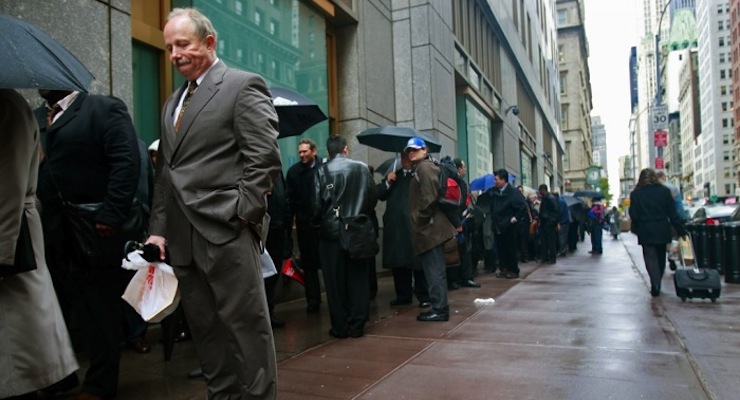

IRS building in New York. (Photo: Mario Tama/Getty Images)
The U.S. economy added only 142,000 jobs in September and the number of Americans in labor force participation is at the lowest level since October 1977. The Labor Department said the headline unemployment rate held steady 5.1% due to labor participation and real unemployment remained above 10%.
The civilian labor participation rate declined to 62.4% in September, a clear sign that discouraged job seekers, of which there were 635,000, are no longer even looking for work. The September jobs report showed the smallest number of men ever are currently participating in the labor force. The more important but less-cited employment-population ratio also fell to 59.2% in September, and has shown zero movement–let alone improvement–for the first 8 months of the year.
The number of persons unemployed for less than 5 weeks increased by 268,000 to 2.4 million in September, offsetting a decline in August. The number of long-term unemployed Americans–those jobless for 27 weeks or more–clocked in at 2.1 million in September and accounted for over a quarter (26.6%) of the unemployed. Nearly 2 million (1.9M) were marginally attached to the labor force. These are Americans who were not in the labor force, wanted and were available for work, and had looked for a job sometime in the prior 12 months. However, they are not counted in the unemployment numbers because they had not searched for work in the 4 weeks prior to the Bureau of Labor Statistics survey.
The number of persons employed part time for economic reasons–also called “involuntary part-time workers”–actually declined by 447,000 to 6.0 million in September. But not becauuse they found full-time jobs. Most of these individuals, who would have preferred full-time employment, were working part time because their hours had been cut back or because they were unable to find a full-time job, simply quit on the American dream.
Even more concerning, average hourly earnings (wages) actually fell to $25.09 per hour in September after seeing an increase of 9 cents per hour in August. While many economcists were hopeful the August increase represented an upward trend in wage growth, it was apparently temporary. Wage growth has been a key indicator for the Federal Reserve, which is weighing the timing and trajectory of an expected rate hike later this year. The Fed policy-making members at FOMC were looking for signs of sustained growth in the U.S. economy, but they clearly didn’t get it in September.
In theory and historically, wages increase on simple supply and demand. If more people are working then it is harder for employers to fill positions. Thus, they are forced to raise wages to compete to fill empty positions. But that isn’t happening. The higher-wage paying sectors continue to trend negative amid overly burdensome government regulations. Employment in mining, for instance, continued to decline in September (-10,000), with losses concentrated in support activities for mining (-7,000). Mining employment has declined by 102,000 since December 2014. Similarly, manufacturing growth has been non-existent. In fact, in September regional manufacturing indexes all showed contraction, with the national ISM survey barely above growth.
Meanwhile, job creation numbers for the summer months were revised downward from the Labor Department’s initial reporting. The number of jobs created in July was initially reported as 245,000 but was revised downward to 223,000, and August was revised from 173,000 to 136,000. With the revisions, job gains in July and August combined were a whopping 59,000 less than initially reported. Now, job gains have averaged 167,000 per month over the past 3 months, well below the historical averages and the 250,000 needed to simply keep pace with population growth.





